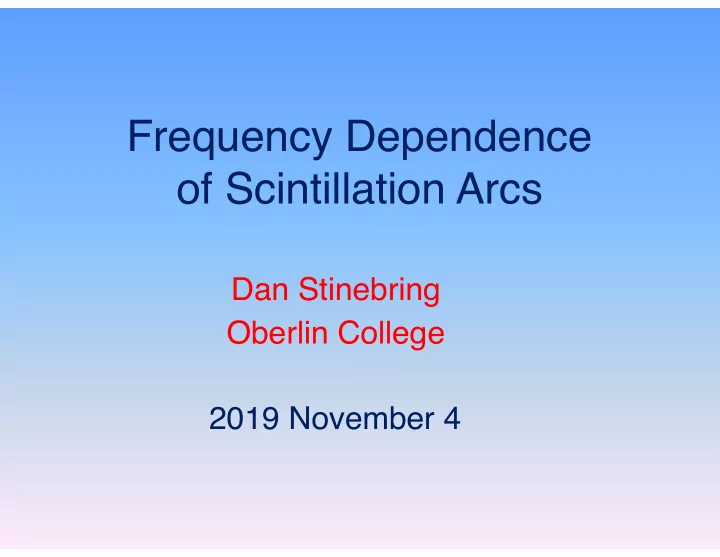

Frequency Dependence of Scintillation Arcs Dan Stinebring Oberlin College 2019 November 4
(Time Variability)
Tilted 0355a Roger Foster, GB 140 ft
Tilted 0355b Roger Foster, GB 140 ft
Tilted 0919a
Tilted 0919b
Questions • Can we distinguish between - anisotropic Kolmogorov scattering - distributed core + “crack in the glass”? • How is arc morphology affected by observing frequency (strength of scintillation)?
B1133+16 6 µ s 90 µ s
B1133+16 6 µ s 90 µ s delay is frequency independent
B0628–28 340 MHz 825 MHz
B0818–13 340 MHz 825 MHz
B1508+55 340 MHz 825 MHz
B1540–06 340 MHz 825 MHz
B2021+51 340 MHz 825 MHz
B2045–16 340 MHz 825 MHz
B2327–20 340 MHz 825 MHz
B2310+42 340 MHz 825 MHz
Concluding Comments • Can we distinguish between … - Maybe. Needs to be done quantitatively. • How is arc morphology affected by observing frequency (strength of scintillation? - Very strongly. Need to look at frequency evolution in order to understand models.
slides not shown …
Preamble to conjecture: all (or almost all) of the Kolmogorov ray tracing simulations you’ve seen assume a single thin screen along the LOS
Conjecture: rays scattered by a distributed Kolmogorov medium do not produce pronounced scintillation arcs
rays random walk in a distributed medium A. Jussila 2018 Oberlin honors thesis
The statistical connection between delay and Doppler (in this case) is a selection effect. It’s real, but it needs further quantitative exploration to see what sort of scintillation arcs it produces, if any. Cordes, Shannon, & Stinebring 2016
B0628–28 DM = 34 pc cm -3 distance = 320 pc
B0628–28 DM = 34 pc cm -3 distance = 320 pc Conjecture distributed scattering
B0628–28 DM = 34 pc cm -3 distance = 320 pc but it’s not there!
Recommend
More recommend